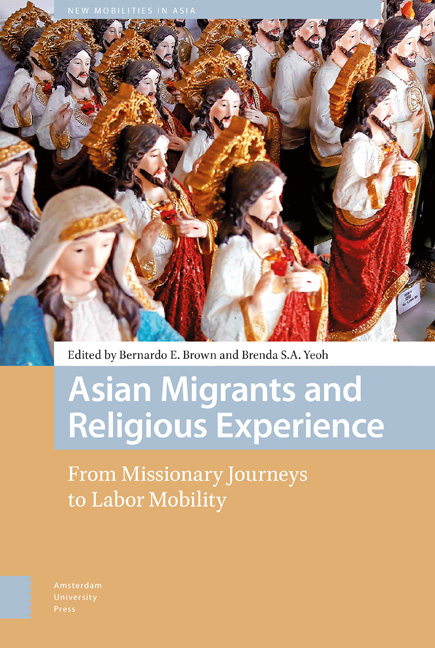Book contents
- Frontmatter
- Contents
- List of Illustrations
- Acknowledgments
- 1 Introduction: Human Mobility as Engine of Religious Change
- Section 1 Mobile Religious Practices
- 2 Saving Yogis: Spiritual Nationalism and the Proselytizing Missions of Global Yoga
- 3 Renewed Flows of Ritual Knowledge and Ritual Affect within Transnational Networks: A Case Study of Three Ritual Events of the Xinghua (Henghua) Communities in Singapore
- 4 Liberalizing the Boundaries: Reconfiguration of Religious Beliefs and Practice amongst Sri Lankan Immigrants in Australia
- Section 2 Transnational Proselytizing
- 5 From Structural Separation to Religious Incorporation: A Case Study of a Transnational Buddhist Group in Shanghai, China
- 6 “10/40 Window”: Naga Missionaries as Spiritual Migrants and the Asian Experience
- 7 Religion, Masculinity, and Transnational Mobility: Migrant Catholic Men and the Politics of Evangelization
- 8 Helping the Wounded as Religious Experience: The Free Burma Rangers in Karen State, Myanmar
- Section 3 Refashioning Religiosity in the Diaspora
- 9 A Multicultural Church: Notes on Sri Lankan Transnational Workers and the Migrant Chaplaincy in Italy
- 10 “Bahala Na Ang Diyos”: The Paradox of Empowerment among Filipino Catholic Migrants in South Korea
- 11 Feeling Hindu: The Devotional Sivaist Esthetic Matrix and the Creation of a Diasporic Hinduism in North Sumatra
- 12 Afterword: What Makes Asian Migrants’ Religious Experience Asian?
- References
- Index
6 - “10/40 Window”: Naga Missionaries as Spiritual Migrants and the Asian Experience
Published online by Cambridge University Press: 12 December 2020
- Frontmatter
- Contents
- List of Illustrations
- Acknowledgments
- 1 Introduction: Human Mobility as Engine of Religious Change
- Section 1 Mobile Religious Practices
- 2 Saving Yogis: Spiritual Nationalism and the Proselytizing Missions of Global Yoga
- 3 Renewed Flows of Ritual Knowledge and Ritual Affect within Transnational Networks: A Case Study of Three Ritual Events of the Xinghua (Henghua) Communities in Singapore
- 4 Liberalizing the Boundaries: Reconfiguration of Religious Beliefs and Practice amongst Sri Lankan Immigrants in Australia
- Section 2 Transnational Proselytizing
- 5 From Structural Separation to Religious Incorporation: A Case Study of a Transnational Buddhist Group in Shanghai, China
- 6 “10/40 Window”: Naga Missionaries as Spiritual Migrants and the Asian Experience
- 7 Religion, Masculinity, and Transnational Mobility: Migrant Catholic Men and the Politics of Evangelization
- 8 Helping the Wounded as Religious Experience: The Free Burma Rangers in Karen State, Myanmar
- Section 3 Refashioning Religiosity in the Diaspora
- 9 A Multicultural Church: Notes on Sri Lankan Transnational Workers and the Migrant Chaplaincy in Italy
- 10 “Bahala Na Ang Diyos”: The Paradox of Empowerment among Filipino Catholic Migrants in South Korea
- 11 Feeling Hindu: The Devotional Sivaist Esthetic Matrix and the Creation of a Diasporic Hinduism in North Sumatra
- 12 Afterword: What Makes Asian Migrants’ Religious Experience Asian?
- References
- Index
Summary
Abstract
The main aim of this chapter is to examine the role Naga missionaries, from the Indian state of Nagaland, play in helping us to understand the idea of “spiritual migration”. I want to reflect on the strategic mobility of spiritual migrants “called” to a place not by human design but by divine sanction, and the motivation for this migration being, in part, the impact it will have on the home territory. This chapter will examine Naga Baptist missionaries going to specific parts of Asia and will focus on three questions: 1) what motivates these missionaries; 2) in what ways missionaries negotiate and navigate the worlds beyond their immediate context; and finally 3) how these processes relate to the broader ideas of mission that highlight the nexus between territorial and cosmic narratives.
Keywords: Naga Baptists, 10/40 window, missionaries, spiritual migration, spiritual capital, sovereignty
Introduction
The main aim of this chapter is to examine the role Naga missionaries, from the Indian state of Nagaland, play in helping us to understand the idea of “spiritual migration”. In an important sense, human history has been marked by migration – in a way, we are all migrants. On an abstractlevel at least, the term “migration” is a difficult concept as it encompasses a number of interlinked factors – political, economic, social, historical, and religious. Although there has been some research on migrants’ religious experience in destination countries (Adogame 2012; Kahl 2014), I want to reflect on the strategic mobility of spiritual migrants “called” to a place not by human design but by divine sanction, and the motivation for this migration being, in part, the impact it will have on the home territory. In this sense, the chapter advances our understanding of the relationship between mobility, religious networks, and the transnational dynamic, and how it aims to generate new social and cultural dynamics both in destination and home contexts (Brown & Yeoh, this volume).
This chapter examines Naga Baptist missionaries going to specific parts of Asia – China, Thailand, Cambodia, and Laos. It focuses on three questions: 1) what motivates these missionaries; 2) in what ways missionaries negotiate and navigate the worlds beyond their immediate context; and finally 3) how these processes relate to the broader ideas of mission.
- Type
- Chapter
- Information
- Asian Migrants and Religious ExperienceFrom Missionary Journeys to Labor Mobility, pp. 153 - 176Publisher: Amsterdam University PressPrint publication year: 2018
- 1
- Cited by

